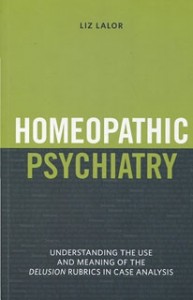Author: Liz Lalor
Reviewed by: Dr. Firuzi Mehta
First Edition 2011
Published by B. Jain Archibel S.P.R.L.
Printed in India
ISBN: 978-2-87491-016-6
Hardbound
No. of pages: 851
€ 38.00 | US$ 50.00 | £ 32.00 | INR 2650.00
Having completed one reading of all 851 pages of Liz Lalor’s book ‘Homeopathic Psychiatry – Understanding The Use And Meaning Of The Delusion Rubrics In Case Analysis’, I am now wondering how I can create a concise write-up about this book. It is not as simple as I thought it would be, for the simple reason that the book is more complex than it appears at first glance. For those who will read the book, it attempts to bring a deeper understanding of the Delusion rubrics in the Mind section of our repertories.
The author, Liz Lalor, has a background in Psychology and she brings her 30 years of counselling experience into this enormous and painstaking work. For too long, the important Delusion rubrics have been either neglected from a lack of understanding or misused by being taken literally or completely misinterpreted.
The book undertakes a psychoanalytic study of the meaning and application of Delusion rubrics in homeopathic case taking and case analysis. Liz Lalor emphasises the fact that it is necessary to properly understand why a constitutional remedy profile needs the psychological delusions that it has. With this understanding, we can recognise the remedies our patients need with greater ease. Different remedies have their own different needs of maintaining a certain delusion. Once we identify the psychological behavioural patterning that is inherent within the remedy profile, this insight can be used to identify the Simillimum.
In the beginning of this book, she has laid down four necessary requirements for the use of the Delusion rubrics. She clearly demarcates when the Delusion rubrics are to be used in comparison with similar non-delusion Mind rubrics.
A section on Rubric Categories follows, where she identifies the five stages that a patient will progress through in case-taking and then she uses these stages to group the Delusion rubrics accordingly. This is an important part of the case analysis process, because recognising the psychological stages helps in finding the Simillimum by narrowing down the remedies being considered. In explaining the Delusion rubrics in each different category, she analyses and describes numerous remedies, making the Delusion rubrics come alive for the reader.
The latter part of the book has the Case Companion to Homeopathic Psychiatry, where she presents twelve cases from her practice and takes her readers step-by-step with her, explaining the process of identifying the Delusion rubrics and using them to arrive at the Simillimum.
This book does not make for easy reading – it requires time and concentration to process everything that Liz Lalor writes and for the book’s full impact to be felt. In fact, I need a second reading and look forward to whatever new insights a repeat reading will bring to this complex subject.
So what has this book brought to me? It has brought me the realisation of how I have often neglected the Delusion rubrics. Reading this book has brought me several ‘VOILA!’ moments where understanding and clarity have dawned suddenly and I have identified remedies for some patients whose cases have seemed stuck. I can see that correct application of Liz Lalor’s work will be very helpful in homeopathic practice.
As regards printing quality, B. Jain Archibel deserve congratulations. Paper quality, binding and print are all very good. It has been a pleasure to read this book.
Published at hpathy.com in November 2012
